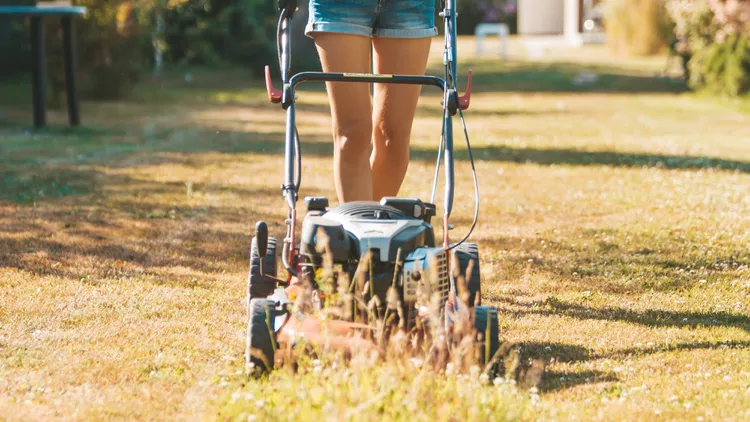Grass demands mowing at least once a week during spring and summer in most regions. But should you mow when an extended dry period hits and your lawn goes from lush and green to dry and crispy? If you're relying on rainfall, it may be best to take a break from mowing during drought, but don’t neglect lawn care altogether. These tips will help tell if your lawn is too dry to mow, and how to best care for it through drought.
Why Your Grass Is Turning Dry and Brown
Drought and heat can cause an unirrigated lawn to turn brown temporarily because the grass goes dormant. Cool-season grasses such as Kentucky bluegrass use this coping technique to survive with a fraction of the moisture they need for good growth. Cold weather is usually what triggers warm-season grasses like bermudagrass and zoysiagrass to go dormant.
In either case, the grass might look and feel dead, but the crown and roots are likely still alive. The blades will green up again as soon as more favorable conditions return. Wait out dormancy with good lawn care practices to help your grass revive and thrive.
Should You Mow Dry Grass?
Every time you mow, the grass is spurred to use water and nutrient reserves to create new growth. Mowing an overly dry lawn quickly depletes moisture reserves, potentially causing more stress than the plants can handle. Only mow during drought conditions if you are providing your lawn with enough supplemental water to prevent it from going dormant.
If you are not watering your lawn through a summer drought, and your grass has become dry and crispy, it will grow very minimally, if at all. Because of this, there is no need to mow while your grass is dormant.
While you pause your mowing routine until your lawn starts growing again, you may notice weeds getting a foothold and rocketing above dormant turf grass. If this starts happening, give your lawn a trim by setting the mower deck high—about a half-inch above the height of the dormant grass. Mow off the tall weeds at that high setting as often as needed to keep weed growth in check.
Lawn Care Tips for Drought
Keep these lawn care tips in mind to avoid stressing your dormant lawn during dry conditions, and to help it bounce back well when conditions become more favorable for your grass to grow again.
1. Hold off on lawn projects.
Delay dethatching and aerating, along with resodding and other lawn renovations, until the grass is actively growing again. Renovation of any type is initially stressful on grass; wait to renovate until the turf has full moisture and nutrient reserves.
2. Mow high.
When dormancy is approaching, raise the mower deck up an inch or two from the regular mowing height. Taller grass will shade the soil, slowing moisture loss and reducing weed competition. Mowing high also promotes a deep root system which is more equipped to mine for water during drought. Continue mowing high, if needed, during dormancy. When grass greens up again and starts actively growing, reduce the mowing height.
3. Water every few weeks.
Dormant grass will survive prolonged dry spells, but it does require about a half-inch of water every two to four weeks. If natural rainfall doesn’t occur, turn on the irrigation system or get out the sprinkler. Water your lawn in one application in the morning to minimize evaporation. Monitor the irrigation system or sprinkler closely to ensure water is not wastefully spraying onto sidewalks and driveways.
4. Delay fertilizer application.
Fertilizer spurs turf grass to grow. Dormant grass does not have moisture available to use the nutrients in the fertilizer. The grass will attempt to grow using the fertilizer but then will quickly wither and die due to lack of moisture. No amount of fertilizer will green up a dormant lawn. Wait to fertilize grass until it's actively growing once again.
5. Stay on top of weeds.
Besides competing with grass for moisture and nutrients, some lawn weeds are able to continue growing in drought conditions. Occasionally mowing a dormant lawn on a high setting can help prevent taller weeds from flowering and setting seeds. If your lawn has turned brown, it can make it easier to see the weeds and either hand pull them or spot treat them with herbicide.
6. Maintain sharp lawn mower blades.
Dull mower blades tear grass blades instead of cutting them. Torn grass blades require 40 to 60-percent more water to recover from mowing than grass cut with sharp blades. If you must mow during hot, dry conditions, ensure your blades are sharp. Take time to sharpen mower blades at least twice a year.




















